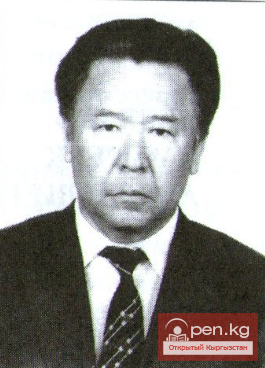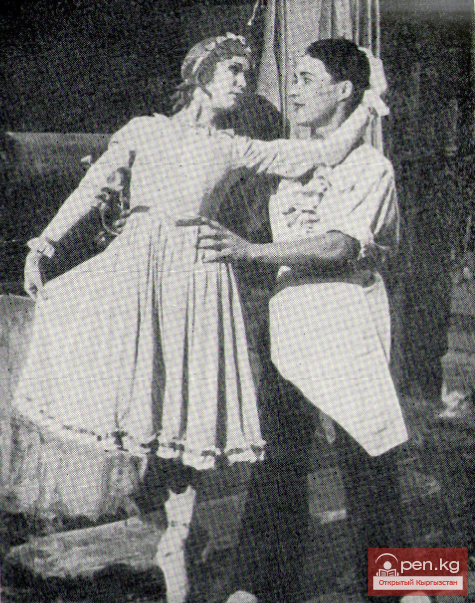
Umetov Jumabay (1933-1995) Applied artist. People's Artist of the Kyrgyz SSR. Laureate of the...

GOLUBEV Vladimir Andreevich...

Abdullaev Mukash Tursunovich Applied artist. Born on October 12, 1935, in the city of Tokmok,...

Akmatova Kulnar Rymbekovna Designer. Born on July 12, 1960, in the village of Chyrpykty, Issyk-Kul...

Dzhumaliev Muratbek Toktorovich Sculptor. Born on May 12, 1965, in Frunze. In 1984, he graduated...

Dzhumabekov Asein Kasymovich Painter, monumental artist. Born on March 15, 1960, in the city of...

For the first time in 40 years, from November 7 to 10, 2014, the Kazakh State Academic Theater of...

Gromova Marina Borisovna Designer. Born on May 2, 1954, in Leningrad. In 1977, she graduated from...

Artykbai Jeenbay Mamatjunusovich Applied artist. Honored Educator of the Kyrgyz Republic. Born on...

Shtoffer Yakov Zinovievich Theater artist. Honored Artist of the Kyrgyz SSR. The name of Y....

Kalychbekov Erkin Applied artist. Born in 1947 in the village of Kashka-Suu. In 1967, he graduated...

Sartbaev Bolot Karataevich Designer. Born on May 28, 1955, in the city of Jalal-Abad. In 1976, he...

Diversity of Monumental Painting and Decorative Plastic Arts. In the 1960s, the traditional...

Arefyev Anatoly Vasilievich – Soviet theatrical artist, People's Artist of the USSR since...

Tenizbaeva Begayim Sadikovna Applied artist. Born on September 18, 1954, in the city of Frunze. In...

Lysogorov Evgeny Evgenievich Applied artist. Born on May 17, 1951, in the city of Ush-Tobe,...

Idirisov Ormonali Tashpolotovich Painter Born on September 14, 1959, in the village of Kirkol,...

Dmitry Evgenievich Lysogorov Graphic designer. Born on March 9, 1947, in the city of Kobrin, Brest...

Kurmanov Talai Graphic artist. People's Artist of the Kyrgyz Republic. Born on May 22, 1949....

Bakirov Ibragimov Bakirovich Designer, spatial environment decorator. Born on June 8, 1957, in the...

Bakashov Sabitjan Monumentalist. Painter. Born in 1941 in the village of Ak-Terek, Ton District,...

Akmatov Aitbek Sadyrkulovich Applied artist. Works in the field of book illustration. Born on...

Bibisara Beishenaliev and her partner Uran Sarbagishev as Juliet and Romeo In 1961, the Kyrgyz...

Toktogonov Eshbolot Ajibayevich Applied artist. Honored Worker of Culture of the Kyrgyz Republic....

At the Kyrgyz National Academic Theatre of Opera and Ballet named after A. Maldybaev, preparations...

Osmonalieva Roza Applied artist. Born on January 27, 1965. In 1984, she graduated from the S.L....

Musabay Gulnara Bekturovna Graphic artist. Born on December 5, 1954, in the city of Frunze. In...

Mutual Influences of Folk and Stage Choreographic Cultures In the first Kyrgyz ballet...

Update of the performers in the 1950 production Ten years after the first production of...

Clarity of the creative task presentation. As an active multifaceted monumental artist, Jyldyz...

Akhunov Urumbay Watercolor artist. Born on March 21, 1923, in the city of Fergana. In 1951, he...

Scene from the second act of the ballet "Romeo and Juliet": B. Suslov as Tybalt, E....

Kerimbekov Aibek Kulchoroevich Painter. Born in 1959 in Frunze. In 1979, he graduated from the...

In the 1960s, in Kyrgyzstan, as in other republics of the country, a new stage in the development...

Images Created by U. Sarbagishev The next two years did not bring Sarbagishev much creative...

Jumabay Umetov is an applied artist by nature and profession, who engages extensively in landscape...

Sarbagishev Uran Otunchievich - People's Artist of the Kyrgyz SSR Kyrgyz and Soviet ballet...

The music festival was dedicated to the 75th anniversary of the birth of the outstanding Kyrgyz...

The First Steps Towards Professional Kyrgyz Ballet Folk dances, based on elements of rituals and...

Before the revolution, the Kyrgyz people knew visual arts only in its folk, applied form. The art...

Kyrgyz National Academic Theater of Opera and Ballet named after Abdylas Maldybaev The Kyrgyz...

Tatiana Mikhailovna Katz Artist, specialty "art glass." Born on September 15, 1946, in...

Artistic Design by A. V. Arefyev The role of the artistic design created by the People's...

The Folk-Stage Style of Kyrgyz Choreography Dance enthusiasts can learn a lot and find interesting...
The incredible beauty of Kyrgyzstan's nature...